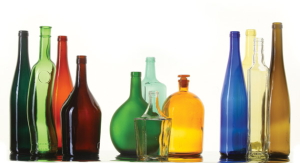Exploring the variations in size, shape and color.

Wine bottles are available in a variety of different shapes, colors and sizes. The standard size of a wine bottle is 750 mL (25 ounces), but bottles can be as large as 500 ounces (the Nebuchadnezzar, a rare large-format bottle).
The three most common bottle shapes are Bordeaux, Burgundy and German Riesling. Ordinarily, wine comes in glass bottles, the best way to preserve the life of the wine. Other containers such as cardboard boxes or plastic bottles are insufficient for long-term wine preservation. Although the modern era of wine storage utilizes the glass bottle, ancient Rome used larger vessels known as amphora jars to store and transport wine. An amphora, also used by the Greeks, is typically a large pottery jar with two handles for ease of transport and pouring of wine. The porous jars were sealed with a pine resin to prevent leakage and protect the wine from exposure to oxygen. The jars were marked or stamped on the bottom along with various symbols that could be added to the sides to identify the pottery and its owner.
While on a recent trip to northern Italy, I discovered a few smaller wineries still using amphora jars for the making and storage of wine. The Romans are credited with inventing the technique for glass blowing, which indicates an early use of glass bottles for wine. Pottery and stoneware were popular until the 17th century, when the capabilities for commercial glass production became available. Wine bottles from Bordeaux, France, are cylindrical in shape with a short neck. This bottle style is used throughout the world for both red and white wines. The Rhone and Burgundy regions of France produce a bottle with a fatter, rounder shape and a longer neck than the Bordeaux bottles. This same shape is frequently used for chardonnay from around the globe in honor of the famed chardonnay, white Burgundy.
German wine bottles are tall and thin with an elongated neck. This tall, sleek bottle is also used for the Picpoul wines of Languedoc, France, along with the French muscadet wines. The Chianti wines from Italy are characteristically in a bottle with a round bottom wrapped in a straw basket. Today’s wineries from this region are offering a premium Chianti packaged in the more traditional Bordeaux-shaped bottle. Even though the contour of the bottle varies, this does not necessarily reflect the quality of the wine. The challenge with so many different shapes is that they may be difficult to store. The indention on the bottom of the bottle, known as the punt, also varies in size and is important for restaurant sommelier service. Sommeliers place their thumb in the punt to assist in the pouring of the wine. The deeper the indention, the easier it is to control and grip the bottle. For example, a bottle with an exceptionally large punt is the Dept. 66 wine from winemaker Dave Phinney of Orin Swift.
Consideration for the color of the glass used is also a key part of the wine bottle. A darker-colored glass will protect the wine from the sun (the sunlight can break down the antioxidants such as vitamin C and tannin, which affect the life of the wine). Lighter-colored or clear glass is typical of large-production wines meant for immediate consumption. Different countries use different colors for their wine bottles, although the principal colors for the bottles are green (light or dark), blue and amber. Bordeaux will have dark green for reds, light green for drier-style whites and a clear glass for sweet whites. In this case, Bordeaux will use a clear glass to show the beautiful color transition of the wine as it ages. Burgundy bottles are green; Champagne will be dark to medium green; rosé from Champagne uses a lighter-colored or clear glass to accentuate the beauty of the rosé wine color. The Mosel region of Germany frequently uses green bottles, while most of the Rheingau region of Germany uses the amber-colored bottles. Both regions occasionally use blue. The density of the glass used for a wine bottle differs according to the winery. A heavier bottle serves as protection from breakage and also gives prominence to the bottle. The impressionable weight of the bottle is often associated with a premium-quality wine (the winery spared no cost to produce an intense and sophisticated bottle of wine). Lighter-weight bottles offer less expense both for production of the wine and for shipping, which keeps the cost down for consumers; they also have a smaller carbon footprint on the environment.
The smallest bottle size for wine is 187 mL, customarily produced in a plastic bottle and generally meant to be consumed within the first year of production. Next in size is the 375 mL bottle, also known as the “half bottle.” The 375 mL bottles are available in most fine dining restaurants. The size of the bottle can also affect aging of the wine. The 375 mL bottles have the shortest aging capability because the ullage of these bottles is equal to a 750 mL and larger bottle. (Ullage is the headspace between the wine and the cork or closure of the wine bottle). After the 375 mL bottle, the next size and most universal is the 750 mL bottle, which is known as the “standard size bottle” (abbreviated as SSB).
The Burgundy and Champagne regions of France are renowned for bottles larger than the 750 mL. The next size is a 1.5 mL bottle, also known as a “magnum” (equal to two SSB). Next are the jeroboam (aka double magnum, equal to four SSB), the Rehoboam (six SSB), the Methuselah (eight SSB), the Salmanazar (12 SSB), the Balthazar (16 SSB), and lastly the very rare Nebuchadnezzar (20 SSB).
By Denis Easdon
Denise Easdon is a certified sommelier and a certified specialist of wine.









0 Comments